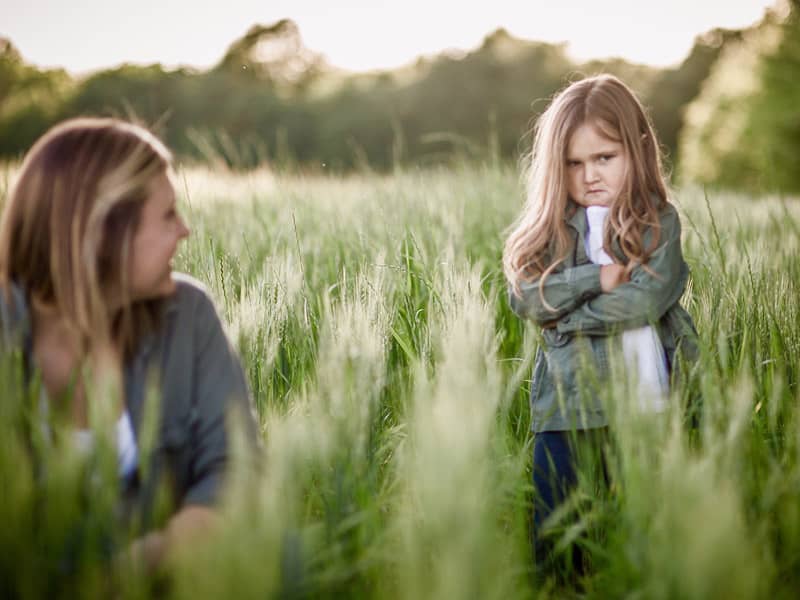Up to about 6 months, most babies are unaware of differences in their primary caretakers, as long as that care is loving, secure, and responsive to their needs. Babies are "intolerant" of hunger and discomfort, but not very discriminating about which adult makes the hurt go away. But by midyear, their visual and other sensory development enables them to distinguish Mom from others, at which point any person looming over the crib--sometimes even Dad or Grandma--who is discovered not to be Mom (or their primary caretaker) may be initially greeted with squalls of protest. Around 12 months of age, this response may slip into separation anxiety, a desire to not be left alone or with an unfamiliar person.
What Can Parents Do?
What's the Goal?
To help your child feel secure enough to move past the stages of separation and stranger anxiety.
By age 3 and 4, children begin to notice differences of all kinds. Just
as they are learning the colors and shapes of objects, they're tuned
into how people look--tall, short, thin, fat, skin color, gender
differences, and disabilities. These new perceptions stem from a growing
sense of their own physical identity and their keen curiosity about the
world. They may comment loudly and embarrassingly on physical
differences--"That man is brown!"--but there is no malice or prejudice
intended. Preschoolers don't categorically exclude people (that's one of their charms), but they may ask a lot of questions. How a parent responds is key to preventing prejudice.
What Can Parents Do?
What's the Goal?
To satisfy preschoolers' natural curiosity about differences while beginning to teach politeness and discretion.
Children in K-2 grades often behave intolerantly because of their dualistic thinking: Kids are either good or bad, smart or dumb, best friends or worst enemies. Girls and boys who used to play together now often separate into gender-specific groups. A child may be oblivious to a friend's race or religion, for example, but may gravitate toward classmates who share their interest in sports or dolls.
Children at this age follow the examples of the important adults in their lives. A child who sees his father refusing to be treated by a female doctor or hears racist remarks from a grandparent, may parrot these prejudices in pretend play.
What Can Parents Do?
What's the Goal?
To get children to notice "hate" words and choose less extreme language, which will help them avoid negative generalizations later on.
As children get older, they absorb a host of prejudicial messages.
Television, movies, and popular music share a lot of the blame; but
intolerance may also be passed on by relatives, friends, and even religious educators.
At school, children find it easy to make fun of others for any number of reasons: being overweight, being the "teacher's pet," or even bringing ethnic food to school for lunch. Such kids are not hardened bigots but are trying to develop a group identity. Increased contact between different groups may not automatically solve the problem; but having to work together for a common goal has been shown to reduce competition.
What Can Parents Do?
What's the Goal?
To correct unfair judgments and encourage cooperation with a variety of children.
Kids this age desperately want to fit in, which often means they feel compelled to go along with the crowd. They may tease or ostracize someone because their friends are doing it. They're not as open as they used to be to their parents'
advice, and they don't automatically assume that what their parents say
is right.
On the positive side, however, preteens are gaining a conscience. They can put themselves in another person's shoes and consider that person's feelings. They also have intellectual curiosity about other cultures.
What Can Parents Do?
What's the Goal?
To teach your child about diversity and foster a strong inner voice that will help her resist pressure to behave intolerantly.
Teens are usually accepting of others their age (though not of adults) and have a well-honed sense of justice that causes them to defend the underdog. At school they're learning at a more advanced level about racism and the Holocaust, and they typically empathize with victims of discrimination. If your teen is a victim of intolerance, talk about peaceful and legal actions your family can take to oppose it.
What Can Parents Do?
What's the Goal?
To raise adults who appreciate both the richness of different cultures and the similarities among people, who see themselves as part of the whole of mankind.

